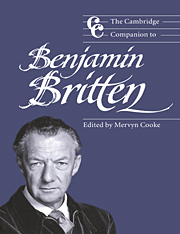1 - Juvenilia (1922–1932)
from Part one - Apprenticeship
Published online by Cambridge University Press: 28 September 2011
Summary
It is clear from the assuredness of his Op. 1, the Sinfonietta, that Britten was already a composer of some experience when he started work on the piece in June 1932 at the age of eighteen. He himself hinted at the extent of that experience in interviews and articles published in the early and mid-1960s, while evidence of it began to emerge in the late 1960s and early 1970s when he released reworked versions of a few childhood pieces: the Five Walztes [sic] for piano, originally written between 1923 and 1925 (published in 1970); Tit for Tat, a collection of songs written between 1928 and 1931 (1968); and a String Quartet in D major written in 1931 (1975). Because of the reworkings, however, the published versions of these pieces are not reliable as indicators of Britten's early achievement. It was only after his death and the establishment in 1980 of the archive in the Britten-Pears Library in Aldeburgh, when access to unrevised material became possible, that a critical portrait of his juvenilia could begin to be constructed.
By 1987 most of the music composed before the Sinfonietta had been listed in A Britten Source Book (BSB), and a few key childhood works had been performed, recorded and published under the auspices of the Britten Estate. Until much more recently, though, the only juvenilia available for study were these works and those donated to the British Library in lieu of death duties, so that commentaries on Britten's early progress have of necessity been circumspect. Now that the entire corpus of extant juvenilia can be surveyed, it is clear that nothing short of an extended study will do it justice. What is offered here is a brief overview, with some more detailed observations on particularly significant pieces.
- Type
- Chapter
- Information
- The Cambridge Companion to Benjamin Britten , pp. 9 - 35Publisher: Cambridge University PressPrint publication year: 1999

